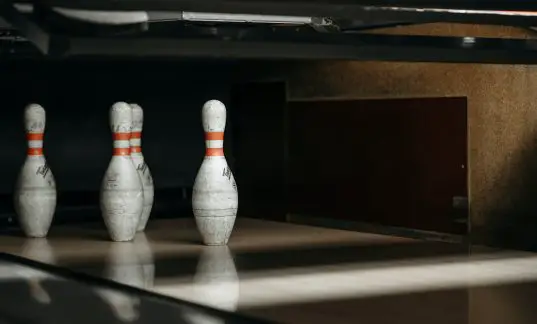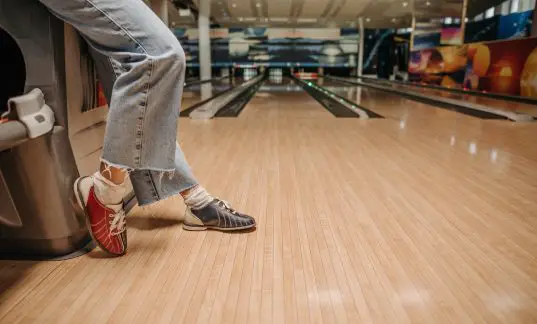If you’re a serious bowler looking to break into the professional ranks for the first time, you’re going to need to develop an understanding of the types of lane oil patterns used at the highest levels of the game.
Whether you’re joining a PBA Experience league or competing with other bowlers in a satellite tournament, slotting balls into the pocket on PBA oil patterns is a lot harder than on a normal house shot. You’ll have to adjust your swing, entry angle, and expected marks to conquer each of the twenty-one patterns developed by the Professional Bowlers Association.
You’ll also need to compile data about the different patterns, including the vaunted scorpion oil pattern. But first, let’s compile some information about the different oil patterns used in PBA-sanctioned games and tournaments.
What are the two types of oil patterns developed for play by the PBA?
The two types of oil patterns used by the PBA are legend patterns and animal patterns. Some of these patterns are long and strong. Some are medium in length with share backend reactions and heavy oil areas dotted across the surface. Some push you to throw inside while others force you to work on the fringes to get to the pins.
There are slow burners and fast patterns that get the jump on you. It’s a complex array of oil patterns designed to test the skills of the best bowlers in the world.
What are the thirteen legend patterns and eight animal patterns used by the PBA?
Depending on the day and the tournament or league you enter, you are likely to encounter one or more of the following oil patterns in PBA-sanctioned play:
Legend Patterns
- Billy Hardwick
- Carmen Salvino
- Chris Paul
- Del Ballard
- Dick Weber
- Don Carter
- Don Johnson
- Earl Anthony
- Johnny Petraglia
- Mark Roth
- Marshall Holman
- Mike Aulby
- Wayne Webb
Animal Patterns
- Bear
- Chameleon
- Cheetah
- Dragon
- Scorpion
- Shark
- Viper
- Wolf
Each of the twenty-one patterns above present and create different problems for players. To improve your chances in a PBA-sanctioned event, you need to bring your A-game and your thinking cap every time you play.
To help you increase your pin carry and your scores in PBA play, we’re going to take a deep dive into one of the most tricky and formidable oil patterns in the PBA oeuvre — the scorpion oil pattern.
What is the scorpion pattern?
An evolution of the normal house patterns employed at most bowling alleys, the scorpion pattern is a long and complex ride that forces right-handed bowlers to push their breakpoint farther to the left (and vice versa for lefties.)
Most fresh Scorpion patterns dictate the pace and position of play, forcing players to take a more direct line to the pins. And compared to shorter patterns with earlier breakpoints, the sheer depth of oil late in the Scorpion pattern will push you to alter the location of your breakpoint for maximum scoring results.
What is the length of a scorpion pattern?
A scorpion pattern is closer to a 44-feet monster pattern than a sport pattern of 35 feet or so. The scorpion oil pattern is 42 feet in length with a hefty oil volume of 30.55mL. Whenever you’re tasked with a longer, more complex oil pattern at the lanes, you’re going to need aggression and pinpoint precision to stay on the lanes and slot into the pin pocket. And while we mentioned earlier that the scorpion pattern evolved from the house shot, it’s a night and day difference playing on the two.
How does a scorpion oil pattern compare to a house pattern?
A typical house pattern covers a smaller surface area than a scorpion pattern. A normal house shot is about 38-40 feet in length and has much less oil density at the end of the pattern. While both patterns push players to work inside, it’s easier to miss your track and veer wildly towards the gutters on a scorpion pattern. Watch videos of players attacking the scorpion pattern on YouTube and you’ll be privy to an unforgiving pattern that, as a rule, punishes mistakes.
Conversely, house patterns are set up with the idea of leveling the playing field for beginners, intermediate bowlers, and experts. You don’t have to read the conditions as much or find your mark farther to the left or right. With a bit of speed, power, and gumption, a house shot is much easier to tackle than the sting of the scorpion.
How is ball speed affected on a lane surface with a scorpion pattern?
It depends upon the strength of your ball, the way you attack the pattern, and your normal speed and revs. If you have a ball that dies in heavy oil and struggles with lengthier oil patterns, you’re going to see a drop-off in speed and impact coming off of your breakpoint. If you tailor your ball choice and lines to meet the demands of the scorpion pattern, working inside while pushing your breakpoint boards out further, you’ll be able to maintain your normal ball speed and even get a lift from the added oil density.
If you find yourself hitting weaker on a scorpion pattern, pay attention to the grit and reactivity of the ball you’re using. If it’s just not up to tackling the pattern, you might need to switch things up.
Should you take a direct line when bowling on a scorpion oil pattern?
The second-longest pattern on the PBA Experience circuit, the scorpion pattern is one of the ultimate measuring sticks for aspiring pros. It requires players to be careful on the outside and push their misses and mistakes inside. Since the pattern is so long, you can make more room to miss inside as long as you keep a relatively direct line to the pin pocket.
Be straighter when the pattern is fresh. Once the scorpion starts to deplete a bit, you can be a bit more creative when your angles and approaches. Until then, be straight and precise with your lines and placements. You’ll be better and perform better for it.
Closing thoughts on the scorpion oil pattern
While some bowlers believe the scorpion pattern is a lower-scoring pattern altogether, that’s not the case if you attack it just right with the right equipment in hand. Week in, week out, there aren’t much tougher patterns out there than the scorpion. But with the right level of aggression and patience, you can turn open frames into spares and strikes — pushing yourself to new heights in your pursuit of professional bowling glory.

